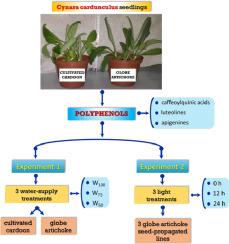Scientia Horticulturae ( IF 3.9 ) Pub Date : 2022-05-11 , DOI: 10.1016/j.scienta.2022.111180 Gaetano Pandino 1 , Angelo Bonomo 1 , Aurelio Scavo 1 , Giovanni Mauromicale 1 , Sara Lombardo 1

|
Cynara cardunculus L. is an Asteraceae member widely diffused in the Mediterranean Basin, rich in phenolic acids (caffeoylquinic acids and derivatives), flavones (luteolin, apigenin and their conjugates), anthocyanins, inulin and vitamin C. Thanks to their numerous biological activities, these compounds are in high demand for food and no-food applications. To match such request, in this research we evaluated the effect of three water-supply (100%, 75% and 50% of plant requirement) and light (24 h, 12 h and 0 h) treatments on the polyphenols profile of C. cardunculus seedlings, with the aim of developing a production system under controlled conditions. Overall, the 100% of plant water requirement increased the amount of caffeoylquinic acids (+28%), luteolines (+27%) and total measured polyphenols (+26%) respect to water-stressed plants (75% and 50% of plant requirement), with cultivated cardoon showing a higher concentration than the globe artichoke. Concerning the light treatment, the trend 0 < 12< 24 h was found for all phytochemical compounds. In particular, 24 h of light strongly induced the biosynthesis of caffeoylquinic acids (+119%), luteolines (+273%) and total measured polyphenols (+129%) compared to 0 h of light. In both experiments, the most abundant compounds were 5-O-caffeoylquinic acid and 1,5-O-dicaffeoylquinic acid. Regardless of experiment, the genetic background showed a significant role, since the responses were genotype-dependent. From these results clearly emerged the possibility of producing polyphenols-enriched C. cardunculus seedlings in controlled conditions.
中文翻译:

受光照和供水处理影响的受控条件下 Cynara cardunculus L. 幼苗中咖啡酰奎宁酸和黄酮的分布
Cynara cardunculus L. 是菊科成员,广泛分布于地中海盆地,富含酚酸(咖啡酰奎尼酸及其衍生物)、黄酮(木犀草素、芹菜素及其结合物)、花青素、菊粉和维生素 C。由于其众多的生物活性,这些化合物在食品和非食品应用中的需求量很大。为了满足这样的要求,在本研究中,我们评估了三种供水(植物需求的 100%、75% 和 50%)和光照(24 小时、12 小时和 0 小时)处理对C.万花筒种苗,目的是在受控条件下开发生产系统。总体而言,相对于水分胁迫的植物(植物的 75% 和 50%要求),栽培的洋蓟比洋蓟的浓度更高。关于光处理,发现所有植物化学化合物的趋势 0 < 12 < 24 h。特别是,与 0 小时光照相比,24 小时光照强烈诱导咖啡酰奎尼酸 (+119%)、木犀草素 (+273%) 和总测量多酚 (+129%) 的生物合成。在这两个实验中,最丰富的化合物是 5 - O-咖啡酰奎尼酸和 1,5- O-二咖啡酰奎宁酸。无论实验如何,遗传背景都显示出重要作用,因为反应是基因型依赖性的。从这些结果清楚地表明了在受控条件下生产富含多酚的C.cardunculus幼苗的可能性。











































 京公网安备 11010802027423号
京公网安备 11010802027423号